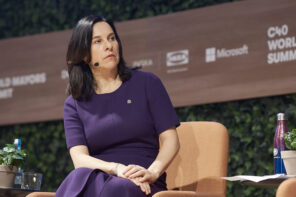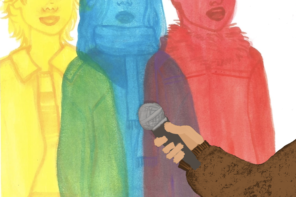Content Warning: This article contains sensitive language and discussions of misogyny.
While grocery shopping recently, I noticed a small, but ridiculous detail in the marketing of the products on the shelf. When it comes to the products we use to groom and prepare ourselves for the world each day, it occured to me that men use dark, bold deodorant bottles called ‘Arctic Edge,’ or ‘Apollo,’ whereas women use flowery shampoos called ‘Wild Cherry Blossom’ or ‘Daily Silk.’
Stroll down an aisle of your local drugstore and you’ll see the sharp contrast of the brooding and indestructible against the soft and sensual — the Trojan soldiers and Axes next to the blooming fruits and flowers. While the names of our toiletries may seem harmless, the stark line that we draw between what it means to be a man and woman influences our world in meaningful ways.
Namely, in the world of politics, this arbitrary gender line is drawn at its very entrance: bold and pronged. The struggle to gain more representation for women in government is an old, but prevailing endeavor. While progress seems slow, it should not be regarded as insignificant. In 2015, Justin Trudeau appointed Canada’s first cabinet with equal gender representation. In the 2018 US midterm elections, 102 women gained seats in the House of Representatives, and the African National Congress Party today has achieved almost 50% female representation.
While what these numbers represent is important, the mindset of there even needing to be a quota for female participation at all reveals that we still define politics, rationality, and our public spheres as masculine.
When it comes to gender equality in politics, however, the conversation is surrounded by numbers and percentages: a certain quota that clearly demarcates progress and righteousness when met. While what these numbers represent is important, the mindset of there even needing to be a quota for female participation at all reveals that we still define politics, rationality, and our public spheres as masculine. With this in mind, I argue that it is not merely enough to increase the amount of women in positions of power if our political structures still have deeply entrenched values of masculinity at their core.
Masculinity is not only tied with politics; it appears inseparable from our conception of power. We feel as though our leaders need to be tough and determined in order to represent the strength of their country and preserve a level of prestige in the global arena. Thus, the language of politics has become expressions of military capability and grit rather than diplomacy; unwavering moral resoluteness is a political virtue whereas compromise is a fallibility.
For instance, during the Iran crisis, President Trump tweeted, “The United States just spent Two Trillion Dollars on Military Equipment. We are the biggest and by far the BEST in the World!” Indeed, even Justin Trudeau used a traditionally masculine sport to strengthen his credibility. In the 2019 election, our prime minister ensured that an image of him training in a boxing ring was captured the morning of the TVA debate, associating traditional forms of masculinity with political leadership capabilities. This is what a ‘politician’ looks like.
If to be masculine is to be strong and rational, thus to be feminine is to be weak and emotional.
We know, of course, that to be feminine is to be many things: including strong, decisive, and powerful. Because societal gender roles for men and women are defined in relation to one another , however, claims of masculinity are essentially also claims about femininity. If to be masculine is to be strong and rational, therefore being feminine is to be weak and emotional. With relations between countries increasingly becoming pompous displays of strength and military capabilities, the constructed idea of being feminine — a limited choice of being either hyper-sexual objects or nurturing and innocent maternal figures — directly opposes it. The norm has been cemented, and the realm of politics deemed one that women inherently don’t belong in.
For example, after being voted into office during the 2019 Canadian federal election, the word “cunt” was spray-painted across an image of Catherine McKenna’s face. A word used to sexualize and demean, this was a direct attack on her womanhood. As Minister of the Environment, McKenna was not only a voice for women, but for our changing climate, both degraded in another insult she endlessly faced: “Climate Barbie.”
And while our country today is considered a global power, when Britain’s satirical magazine Punch wanted to visually represent their colonial power in the 1880s, they depicted Canada as a woman and an “Indian,” in order to “other” us, demonstrating that these notions of masculinity and femininity in defining nations is a historical phenomenon.
Furthermore, because power is attributed to masculinity, feminizing opposing groups weakens them in the public eye and makes them seem easier to dominate. For example, the idea of painting a group as feminine to mark their inferiority has also been used to “other” racial minorities, Indigenous, and queer men.
An equal cabinet or a 50% quota is rendered useless if women must act masculine and hide any part of themselves considered feminine in order to be taken seriously.
In these instances, we see that the underlying issue is not solely about allowing women into positions of power, but introducing and allowing for femininity in these coveted, masculine spaces. An equal cabinet or a 50% quota is rendered useless if women must act masculine and hide any part of themselves considered feminine in order to be taken seriously — in fact, it is unrealistic to expect anyone who wishes to enter a position of power to solely exhibit strength and determination, while suppressing equally important, traditionally feminine traits, such as compassion or the ability to nurture. Numbers lose their meaning if the fundamental structure resists evolution.
Gender constructs remain a ridiculous way of fitting our complexities into simple, two-dimensional molds. Men are not merely powerful and aggressive, just as women are not simply sensitive and demure. I don’t believe any of us embody cultural notions of masculinity or femininity entirely; why should we restrict the institutions that represent us to one?
Compassion and strength are not mutually exclusive, but speak to our common humanity. Therefore, both masculine and feminine traits are needed in the political sphere.








